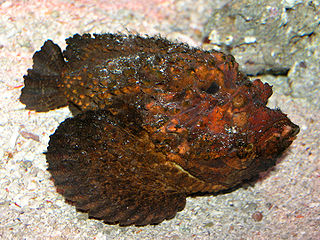
Synanceiinae is a subfamily of venomous ray-finned fishes, waspfishes, which is classified as part of the family Scorpaenidae, the scorpionfishes and their relatives. These fishes are found in the Indo-Pacific oceans. They are primarily marine, though some species are known to live in fresh or brackish waters. The various species of this family are known informally as stonefish, stinger, stingfish and ghouls. Its species are known to have the most potent neurotoxins of all the fish venoms, secreted from glands at the base of their needle-like dorsal fin spines. The vernacular name, stonefish, for some of these fishes derives from their behaviour of camouflaging as rocks. The type species of the family is the reef stonefish.
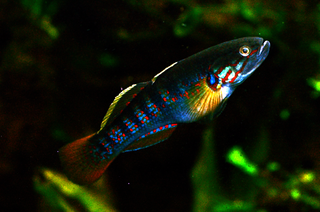
Eleotridae is a family of fish commonly known as sleeper gobies, with about 34 genera and 180 species. Most species are found in the tropical Indo-Pacific region, but there are also species in subtropical and temperate regions, warmer parts of the Americas and near the Atlantic coast in Africa. While many eleotrids pass through a planktonic stage in the sea and some spend their entire lives in the sea; as adults, the majority live in freshwater streams and brackish water. One of its genera, Caecieleotris, is troglobitic. They are especially important as predators in the freshwater stream ecosystems on oceanic islands such as New Zealand and Hawaii that otherwise lack the predatory fish families typical of nearby continents, such as catfish. Anatomically, they are similar to the gobies (Gobiidae), though unlike the majority of gobies, they do not have a pelvic sucker.

Congiopodidae, commonly known as pigfishes, horsefishes and racehorses, is a family of ray-finned fish classified with in the order Perciformes. These fishes are native to the Southern Hemisphere.

Trichogaster is a genus of gouramis native to South Asia from Pakistan to Myanmar. It is the only genus in the monotypic subfamily Trichogastrinae as set out in the 5th Edition of Fishes of the World, although that book states that there are two genera, the other being Colisa which is treated as a synonym of Trichogaster by Fishbase and the Catalog of Fishes. Fishbase also places the genus in the Luciocephalinae. Species of this genus are very popular in the aquarium trade.

Setarchinae, the deep-sea bristly scorpionfishes, is a small subfamily of deep-sea ray-finned fishes, it is part of the family Scorpaenidae. They are small marine fishes, growing up to 25 cm, and are found in tropical and subtropical waters throughout the world.

Apistinae, the wasp scorpionfishes, is a subfamily of venomous, marine ray-finned fishes belonging to the family Scorpaenidae, the scorpionfishes and related species. These fishes are native to the Indian Ocean and the western Pacific Ocean.
Milyeringa veritas is a species of fish in the family Milyeringidae. It is endemic to groundwater and anchialine systems in caves in the Cape Range, Australia. Like other cave-adapted fish, the blind gudgeon is entirely blind and lacks pigmentation, using sensory papillae on its head and body to move around and find food. It has a reduced number of scales on its body and the head is almost scaleless. It reaches a standard length of 5 cm (2.0 in). It is listed as vulnerable under the Australian Environment Protection and Biodiversity Conservation Act 1999. It is an omnivorous species which feeds on algae and possibly also detritus, as well as invertebrates. Invertebrates consumed by M. veritas include Stygiocaris sp., aquatic insect larvae such as those of caddis flies and non aquatic invertebrates which accidentally fall into the water such as isopods, ants and cockroaches. When the gut contents have been sampled 10% of the identifiable gut contents were Stygiocaris and 70% were terrestrial species, despite this species being restricted to caves. They are often observed hanging still in the water column or resting on ledges in the cave walls, behaviours which they also display when kept in aquaria, but can move quickly to avoid capture if threatened, for example when catching them with a net is attempted. The generic name is taken from Milyering which is 20 miles (32 km) southwest of Vlamingh Head in the North West Cape of Western Australia, the type locality, and the specific name is Latin veritas meaning truth an allusion to a quote attributed to the Ancient Greek philosopher Democritus "Truth lies at the bottom of a well, the depth of which, alas! gives but little hope of release.”
Milyeringa is a genus of blind cavefish from the Cape Range and Barrow Island, northwestern Australia. Although traditionally considered to belong to the family Eleotridae, studies show that they represent a distinct and far-separated lineage together with the Typhleotris cavefish from Madagascar, leading some to move them to their own family, Milyeringidae. The generic name is taken from Milyering which is 20 miles (32 km) southwest of Vlamingh Head in the North West Cape of Western Australia, the type locality for Milyeringa veritas.

Zaniolepis, the combfishes, is a genus of marine ray-finned fish, it is one of two genera in the family Zaniolepididae. These fishes are native to the eastern Pacific Ocean. Z. frenata that was a source of food to the Native American inhabitants of San Nicolas Island off the coast of southern California, United States during the Middle Holocene.
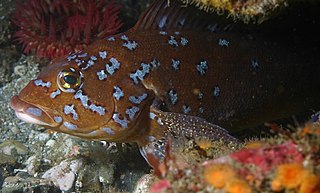
Hexagrammos is a genus of marine ray-finned fishes belonging to the family Hexagrammidae, the greenlings. These fishes are found in the north Pacific Ocean.

Neosebastidae, the gurnard scorpionfishes or gurnard perches, is a small family of deep-sea ray-finned fishes. It is part of the suborder Scorpaenoidei within the order Perciformes. These fishes are found in the Indian and Pacific oceans. Several of the species in this family are venomous.
Milyeringa justitia, commonly known as the Barrow cave gudgeon, is a species of fish in the family Milyeringidae endemic to groundwater systems (aquifers) of Barrow Island, around 50 km off the Pilbara coast in Western Australia. This troglobitic species has a pale body, lacking in pigment, and it is eyeless and blind, using sensory papillae located on the head and body to allow it to feed and move around in total darkness. The specific name justitia is Latin for "justice" and was given by the describers to complement the specific name of Milyeringa veritas which means "truth" in the hope that “As truth and justice are supposed to go together, we name this species justitia, from the Latin for justice, in the hope that justice helps the species to survive on Barrow Island, which has been an oilfield since 1967 and is most recently the site of the Gorgon Gas Hub development.” Very little is known about M. justitia as between 2002 and 2013 only six specimens were collected but its biology is assumed to be similar to that of M. veritas.
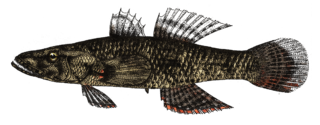
Butidae is a family of sleeper gobies in the order Gobiiformes. The family was formerly classified as a subfamily of the Eleotridae but the 5th Edition of Fishes of the World classifies it as a family in its own right. Molecular phylogenetic analyses have demonstrated that the Butidae are a sister clade to the clade containing the families Gobiidae and Gobionellidae and that the Eleotridae is a sister to both of these clades. This means that the Eloetridae as formerly classified was paraphyletic and that its subfamilies should be raised to the status of families.
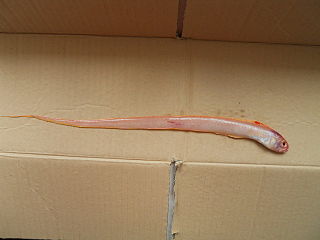
Cepolinae is one of two subfamilies of marine ray-finned fish belonging to family Cepolidae, the bandfishes.
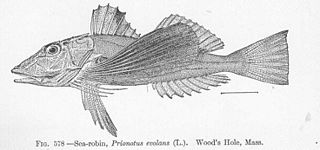
Prionotinae is a subfamily of demersal, marine ray-finned fishes, part of the family Triglidae. The fishes in this subfamily are called sea robins and are found in the Western Atlantic and Eastern Pacific Oceans, the other two Triglid subfamilies are called gurnards.

Triglinae is a subfamily of demersal, marine ray-finned fishes, part of the family Triglidae, the gurnards and searobins. These gurnards are found in all the tropical and temperate oceans of the world except for the Western Atlantic Ocean.

Stichaeinae is a subfamily of marine ray-finned fishes, classified within the family Stichaeidae, the pricklebacks or shannies. These fishes are found in the North Pacific, Arctic and North Atlantic Oceans.

Opisthocentrinae is a subfamily of marine ray-finned fishes, classified within the family Stichaeidae, the pricklebacks or shannies. These fishes are found in the North Pacific Ocean.
Gymnelinae is a subfamily of marine ray-finned fish belonging to the family Zoarcidae, the eelpouts. Most species are found in the North Pacific Ocean but one genus is cosmopolitan, and another is endemic to the Southern Ocean.
Lycodinae is a subfamily of marine ray-finned fish belonging to the family Zoarcidae, the eelpouts. These eelpouts are found are in all the world's oceans, with a number of species being found off southern South America.















